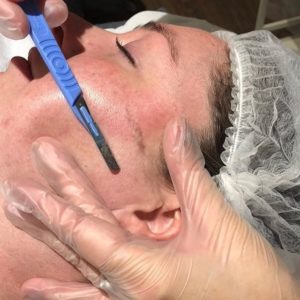No products in the basket.
Blog
Everything You Need to Know About Dermaplaning
Like other cosmetic procedures, dermaplaning too comes with its set of advantages. It helps in removing the top layers of your skin, reduces the fine wrinkles, and provides deep acne scarring, thus leaving the skin surface smooth. Let’s shed light on the details of this treatment.
What is dermaplaning?
As told by experts at the kent beauty academy, Dermaplaning, also referred to as blading or microplaning uses an exfoliating blade to peel out dead skin cells and hairs from your face.
This particular skin treatment makes your skin’s surface look youthful, radiant, and smooth. Not only this, but it is also effective in removing deep scars left on your face due to acne and pockmarks on your skin. The treatment, taught at the Essex beauty training school, works well when it comes to removing short and soft hairs on your face.
Dermaplaning is suitable for any skin type or even when anyone has the following:
● Scars due to acne
● Dullness on the skin
● Dryness on the skin
● Damaged skin due to sun
● Fine wrinkles
How does it work?
The tool used for dermaplaning treatments looks like a razor that you use to remove your body hair.
Dermaplaning involves shaving. A sterile blade is used at a 45-degree angle and dragged slowly all over the skin to remove dead cells, scar tissue, and other debris that make your skin look uneven and dull.
Your skin often remains exposed to harsh environmental toxins, sun damage, and irritants. With time, these elements can damage your skin and make it look aged and dull. With dermaplaning, you can get away with the damaged skin cells so that you develop newer skin cells.
However, when it comes to the results, everyone has a different experience with this treatment.
What is the procedure?
Dermaplaning comes under semi-permanent makeup courses and is not a painful procedure; however, you might experience a tingling sensation in between.
You will be seated in a comfortable position, after which local anesthesia or numbing spray is given to sedate the skin. Along with this, you will also get general anesthesia in rare cases or an oral sedative.
After you are relaxed, an electronic or manual dermaplaning tool is used to scrape your skin at a 45-degree angle. The process will be carried out for 20-30 minutes, on average, to exfoliate the skin thoroughly.
Once the treatment is over, a substance such as an aloe gel is applied on your face along with sunscreen to protect your skin.
What to expect from dermaplaning treatment?
There is no need to worry about the downtime to recover from dermaplaning treatment. Experiencing redness or the feeling of getting your skin scraped is common right after two or three days of the procedure.
It might take a few days to see full results, but you will eventually notice that your skin will start looking brighter right after the treatment. As the redness subsides, you will see results more clearly.
After the treatment is over, you will need to be extra careful with the exposure to the sun. This is because continued exposure might result in pigmentation. Experts recommend that you wear sunscreen every time you step out.
To know more about cosmetic treatments, search for beauty schools near me and learn the nuances with experts.

